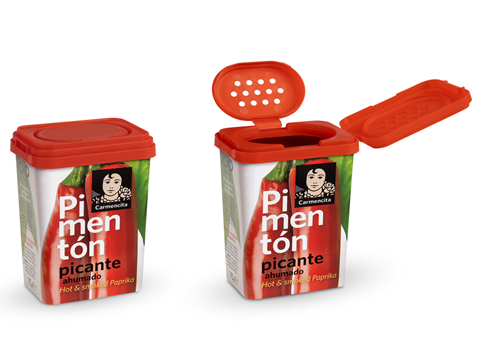
Spanish companies Carmencita and ITC Packaging have collaborated to produce new paprika packaging with light barrier properties and a two-sided flip top cap, designed to ‘revolutionize’ spice shelves in stores.
Initially, the project aimed to improve the features and functions of the two-sided flip tops traditionally used by the spice industry, which led the two firms to develop a hinged two-sided flip top solution. Apparently, the cap can be opened in two different ways, either to remove the spices using a spoon or directly sprinkle them.
The companies then further developed the container design to include a heat-sealable cap-jar join to help preserve the product, and the IML label, which is said to act like a barrier to protect it from UV rays.
The new packaging reportedly uses much less raw material and has better cubage thanks to its ‘optimized stackability’, which the companies state reduces its carbon footprint. The packaging is also mono-material and can be recycled using existing waste management systems.
In 2023, JOZO’s decorated saltshaker tubes have adopted a new, user-friendly dosage cap and MCC Verstraete’s NextCycle IML labels in collaboration with SFA Packaging, CIRCPACK, and Veolia, with the end goal being circular packs that produce high-quality recycled polypropylene. The tube received a Class B classification in 2022, meaning that, minus ‘minor recyclability issues’ that have slight impacts on the resultant recyclate, most of the components could contribute to a closed loop.
More recently, Blue Ocean Closures’ fibre-based screw cap, which is recyclable in paper waste streams, is set for a commercial launch in partnership with Great Earth – a Sweden-based producer of nutritional supplements. Blue Ocean Closures says that its 95% fibre cap contributes to a “significant” carbon footprint reduction.
Yangi announced its new fibre-based container lid for dry and ambient food products last month, made from 100% renewable material and designed to meet growing consumer preference for environmentally conscious options. The cellulose-based container lids apparently fit into worldwide recycling systems.
If you liked this story, you might also enjoy:
How are the top brands progressing on packaging sustainability?
Sustainable Innovation Report 2024: Current trends and future priorities
Reuse vs. single use – which is better for the environment?
The ultimate guide to global plastic sustainability regulation












No comments yet